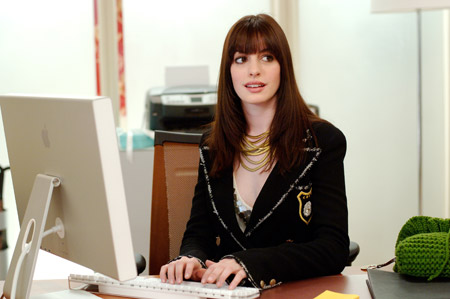The Devil Wears Prada
 Andy Sachs (Anne Hathaway) is a recent graduate of Northwestern University looking for a job in New York. After some shots of her and some glamorous others dressing for the day in clothes too ridiculously impractical to be taken seriously by any employer, save the entertainment and fashion industries, she appears for her interview with Miranda Priestly (Meryl Streep), the editor of …
Andy Sachs (Anne Hathaway) is a recent graduate of Northwestern University looking for a job in New York. After some shots of her and some glamorous others dressing for the day in clothes too ridiculously impractical to be taken seriously by any employer, save the entertainment and fashion industries, she appears for her interview with Miranda Priestly (Meryl Streep), the editor of …

Photo credit: Barry Wetcher.
… or as I like to call it, “The Flavor of Hubris.”
Andy Sachs (Anne Hathaway) is a recent graduate of Northwestern University looking for a job in New York. After some shots of her and some glamorous others dressing for the day in clothes too ridiculously impractical to be taken seriously by any employer, save the entertainment and fashion industries, she appears for her interview with Miranda Priestly (Meryl Streep), the editor of Runway. The film is based on the experiences of Lauren Weisberger, former assistant to Anna Wintour, editor of Vogue.
Does an industry so self-promotional need any more advertisement? Apparently, Twentieth Century Fox thinks so. The story does, as you may predict, involve Sachs’ choice between boyfriend and career. Emily (Emily Blunt), the incumbent whom she will eventually replace, serves as the stereotypically rash British type—following in the footsteps of every television program presently ripping off the Simon Cowell/Anne Robinson formula that died along with the popularity of “The Weakest Link.” Nonetheless, the cute and, by comparison, folksy Andy continues to attempt befriending Emily with details about her life outside work.
As she becomes more resolute in weathering the storm of the job in the hopes of leveraging the experience into a better one, Andy becomes one of the herd—alienating her friends and boyfriend. Her new set of friends at work include the blithe (read: gay-ish but not too gay for PG -13) Nigel (Stanley Tucci) and, rather fortuitously, writer Christian Thompson (Simon Baker). Thompson persuades her to consider writing for his editor at The New Yorker, but she becomes more a slave to her job. Instead of developing any real character conflict, the old plot mechanisms are dragged out of the studio pantry, dusted off and re-used in a story we’ve seen too many times before to really, genuinely give a shit about Andy or the boyfriend we see only as rarely as she—developing less interest in him as a person than she possesses.
While Anne Hathaway finds herself yet again cast in the dreadfully inane role of dork-turned-beauty, Miranda is Meryl Streep’s parody of despicable managers, but then so many in the fashion and entertainment industries are there not because they understand management, but because these are industries so in love with their own legends that they attract those managers and executives who only emulate a child’s impression what management is. Infinitely more truth can be found in the ponderous and relentless micromanagery of Bill Lumbergh in “Office Space.”
Miranda is an editor who finds ways to expend Andy’s resourceful labor wastefully on trivial tasks meant purely to irritate her. Generally speaking, motion picture studios recruit interns to do such mundane work for free… but it may very well be that these were real circumstances in such an industry of circus freaks. Yes, Tod Browning’s classic does come to mind. But instead of hearing the lunatic sociopaths at Elias-Clarke Publishing chanting, “One of us. One of us,” we’re given to repetitious montages of Andy taking Miranda’s crap, and Miranda and the industry being lit, blocked and shot not as the slave drivers they are, but as paragons to which we all should aspire. And of course somewhere in the middle there’s the obligatory derision of Fox (see “The Simpsons”) which is played lightly for gags rather than scathingly honest criticism.
After the movie, I walked out of the theater and the intern representing Fox asked me if I liked the film. I replied that I felt it was too PG in its depiction of the industry, as the real Anna Wintour has probably said and done things to her interns that would get an “R” rating. Perhaps those aren’t exactly encouraging words for a young PR intern to hear. What I really wanted to ask her was whether or not seeing the film altered her perspective on the work she does. In other words, I wanted to ask her if she understood that there are greater things in life to which one can aspire than being a shameless doormat, and that by “greater things” I don’t mean paying jobs with larger cubicles. Her mute expression indicated to me that the PG-13 film had failed miserably to make its alleged point to the intended audience of young adults.
It’s not that I find it entirely implausible for any of Andy’s circumstances to be real. It’s that the director, David Frankel, has clearly been tasked by a major motion picture enterprise to take these events and mold them into the confines of a story that makes studio executives proud, in which the end lesson is that Stockholm Syndrome is a healthy outlook on life for a career gal. Note that the opening shot with the women dressing for their day shows them all, Andy included, kissing their boyfriends goodbye. How can a film purport to be about individuality and independence and yet extol, through cliché and self-obsessed slow-motion shots, conformity and dependence?
 The Devil Wears Prada • Dolby® Digital surround sound in select theatres • Running Time: 109 minutes • MPAA Rating: PG-13 for some sensuality. • Distributed by Twentieth Century Fox Film Corp.
The Devil Wears Prada • Dolby® Digital surround sound in select theatres • Running Time: 109 minutes • MPAA Rating: PG-13 for some sensuality. • Distributed by Twentieth Century Fox Film Corp.